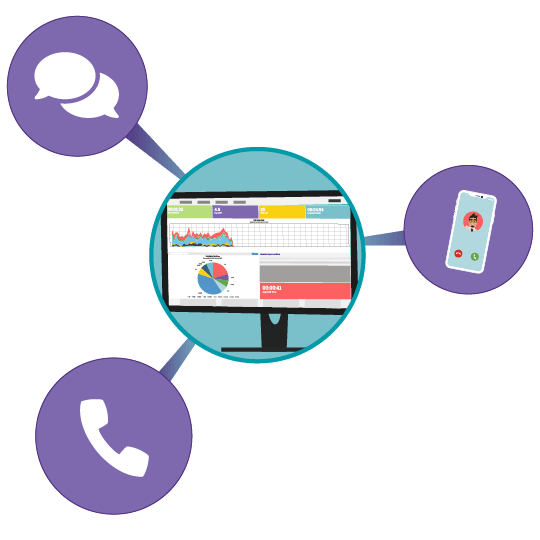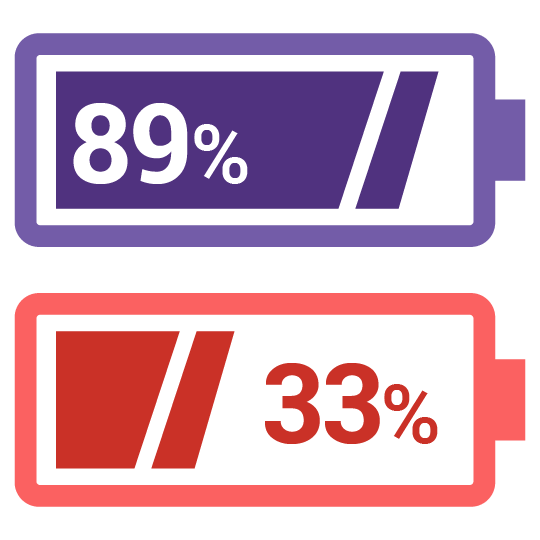
3 Reasons Omnichannel Contact Centers Are the Future
This post was originally published on July 6, 2016, and was updated on November 12, 2018.
Your team’s success depends on your agents’ ability to juggle all the ways your ever-evolving customers reach out for help, without sacrificing a top-tier service experience.
You and your agents are in the unique position to have a massive impact on your company’s bottom line. Satisfied customers turn into loyal customers who spend 31 percent more than existing customers and cost seven times less to retain compared to the costs of acquiring a new customer. And customers are satisfied when you’re able to help them, where they need help and when they need help, without adding stress or more pain to the process. By optimizing your customer service experience and communicating with your customers in a way that works for them, you improve their satisfaction, and ultimately, their lifetime value.
As if your job of monitoring dozens of channels for agent performance, then coaching them on that performance, wasn’t tough enough, add the pressure that 71 percent of customers end their relationships with a company because of a poor customer service experience. Turns out, too, that one of the five root causes of lost relationships is the inability to easily switch between communication channels.
You’re working tirelessly to train your agents to better serve customers, so they don’t teeter over to the low-satisfaction zone. To be successful, you need a way for your agents to move seamlessly through customer interactions, tagging in new channels or customer data when need be. To meet your customers where they are, you have to deliver omni-channel customer service.
Being truly omni-channel means your contact center can move to any channel, at any time, all from a single queue. And not only that, it means all your channels are connected to share information and work together, too.
Here are three reasons omnichannel contact centers continue to take the customer experience cake.
Texting is the ideal channel for a quick back-and-forth.
More than 50 percent of customers would rather text customer service for help than call.
Let’s say a customer of a major national bank adds her teenage daughter to her checking account. And she does it right before she goes off to college. The bank tells the customer that adding a user to her account could take between three and five days to go into effect.
She has to wait for the green light from the bank’s service team before she can access the account.
Instead of having the customer call the bank’s busy helpdesk day by day to check on her account’s status, the bank sets up automatic, daily SMS notifications to let her know the status of the pending change to her account. Now, you keep the customer informed and she automatically gets tagged in when her account is ready to rock, saving the bank the time and resources it takes to handle daily status updates.
It’s one, simple example of using text messages to build a proactive customer service culture and handle requests quickly and effectively.
As you ride the wave of customers seeking low-effort, efficient options, texting should be a central tenet of your omni-channel customer service strategy.
Your move:
Use your reporting and analytics to give you insight into your customers’ journey. Then, see when you can direct customers to quick-response channels, like SMS and MMS.
Picture this: you run a company specializing in consumer appliances and you’ve been ramping up your resources to prep for a promotional sale next week.
Based on previous sales like this one, you know you can expect a high volume of service requests. But your analytics show that a majority of the requests can be solved quickly. Your data also shows that your customers typically text your agents for help when they have simple issues. So, you decide to provide a text us option for customers during the sale.
Since your text capabilities are all housed in your single, omni-channel platform, your agents don’t have to change their process. And your team can still give customers the options they want for service.
The inbound text message will automatically route to the next available agent’s queue, letting the agent respond without jumping between channels.
Omnichannel self-service simplifies the customer experience.
The future of customer service adds in self-service in a much bigger way than we’re using it right now. In fact, in the 2017 Customer Service Barometer survey, American Express found that 60 percent of customers look to self-service options well before reaching out to a person for help.
When you proactively answer customer questions with self-service options, you’re taking some of the burdens of handling mundane tasks off the shoulders of your agents. Deliver resources for easily answered, but often asked questions, like how to change a password, and your customers can quickly problem-solve on their own. Self-service options essentially cut out the need for an agent to field interactions that are common or too simple.
If customers can get answers to their questions without taking up your agents’ time and resources, agent efficiency and effectiveness will spike in your contact center, and it’ll boost your agent morale, too. Some early adopters of self-service reported efficiency gains of 30 percent and lower call volumes for their agents. Plus, your customers will be happier with the gift of a speedy, accurate response without getting on the phone.

The beauty of including self-service options in your omni-channel suite is if agents need to step in to help the customer, they can. And, they can do it while making it feel natural, organic even, to the customer journey.
According to Forrester, email has overthrown voice as the most popular channel for customer outreach. In fact, they say 54 percent of people last year opted to press send to start a customer service interaction.
Customers are moving away from traditional channels, like voice, to find ways to connect that fits into their lifestyle. People are impatient. They want answers, and they want them now. And I get it, I’m impatient too. But that means contact centers of the future have to have an easy way for customers to get the information they need, when they need it, without picking up the phone.
Self-service is a critical piece of the omni-channel customer service puzzle. It wipes out tons of repeat calls, customer frustrations, and slow service processes. All while giving customers the power to communicate with you on their terms.
Your move:
The most popular self-service channels include online forums, virtual agents, and knowledge bases. Provide a thorough and comprehensive knowledge base to cut down on your inbound call volume. And, power bots to serve your customers relevant articles.
Of all self-service channels, Forrester’s 2018 Customer Service Trends report found that customers use knowledge bases most often. Build up a resource library with self-help articles, how-to guides, and video resources to answer your most common questions. Schedule a meeting with your agents and team leaders. Amplify your brain power and come up with a list of FAQs. Look at issues that keep popping up and other problems that likely have a quick fix. Chances are high that you’ll see several of the same customer questions pop up over and over again.
When you use an omni-channel platform powered by A.I., you can monitor for the questions your customers ask across all channels, too. Check your dashboards for repeated inefficiencies. And, set up interaction triggers to notify you about certain words, like “password.” Then, combine your intel to create helpful resources for your customers.
Omni-channel customer service options play well with others.
Staying ahead of the curve as new technologies become mainstream is no easy task.
But keeping up with the current trends in technology can help your business outshine the competition.
When you stay in-the-know with current trends, you’re nimble enough to make changes for the benefit of your customers. What device will a customer use when they need to contact your customer service team? Will they opt for web chat, text, email, social media, voice, or another emerging channel, like video?
True omni-channel contact centers can incorporate new customer channels as they become customer mainstays. Open integrations coupled with a single queue view and skills-based routing make modern contact centers fit to scale.
As the contact center space continues to progress, you’ll have to rely less on traditional voice-based service. Gartner expects that by 2020 85 percent of interactions will take place without involving a human. And, they predict that people will have more conversations with a bot than a spouse.
Live video, social media sentiment monitoring, wearables, and virtual reality gadgets may even creep into the service landscape for some businesses over the next few years. But, omni-channel contact centers are ready and nimble to handle the constant shifts in customer expectations.
Your move:
The best (and only) way to truly ensure you’re adequately equipped to take on any flying object a VR headset throws your way is to find a contact center solution that’s a true omni-channel platform. That means you not only have the capability to handle customer interactions on any channel, but you can switch between channels during interactions, too. And even better, your platform pairs with your other systems to intelligently share customer information. So your agents can customize each interaction.
Omni-channel customer service lets you turn tech disruptions into opportunities to offer more options and better service.
According to Internet Retailer, companies with the strongest omni-channel customer service strategies have a customer retention rate of 89 percent, compared to a retention rate of 33 percent for companies with weak omni-channel strategies.

The bottom line: To give customers the experience they expect, you need easy access to your customers, and the data they can provide, across any channel, at any time.

